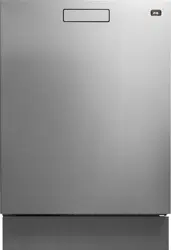Documents: Go to download!
- User Manual - (English)
- Front panel
- Before washing for the first time
- Loading the dishwasher
- Using the dishwasher
- Settings
- Care and cleaning
- Troubleshooting
Table of contents
User Manual
Front panel

The panel is fitted with touch buttons with audible feedback (see the chapter Settings).
Before washing for the first time
Program key
Some dishwashers include program keys in different languages. Attach the program key in the desired language to the top of the door.

Checking water hardness
Contact the local water utility to check the water hardness in your area. This is important with regard to how much detergent and rinse aid to use.
Top up with rinse aid
By using rinse aid you will improve your drying result. You will also achieve a better dishwashing result with glassware and dishes.
- Open the rinse aid compartment lid.
- Carefully top up with rinse aid. Only add rinse aid to the level marked max.
- Wipe up any splashes of rinse aid around the compartment.
- Close the lid firmly.

 Refill rinse aid indicator
Refill rinse aid indicator
When the rinse aid needs topping up, the above symbol lights on the display.
Setting the rinse aid dosage
The section Settings describes how to set the rinse aid dosage. Rinse aid dispensing can be set from  (Off) to
(Off) to  (High dose). (Factory settings:
(High dose). (Factory settings:  )
)
Increase the rinse aid dosage:
- If the dishes have water marks.
Decrease the rinse aid dosage:
- If the dishes have a sticky white/blue film.
- If the dishes are streaked.
- Build-up of foam. If you have very soft water, the rinse aid can be diluted 50:50 with water.
For water with a hardness greater than 10–12 °dH, you ought to use rinse aid with citric acid (known as acid rinse aid).
Loading the dishwasher
Economic dishwashing
Run programs only with a full load
Wait to run a program until the dishwasher is full. This way you save energy. Use the Rinse & Hold program to rinse the dishes if there are any unpleasant odours while you wait for the dishwasher to become fully loaded.
Run programs at a lower temperature
If the dishes are only slightly dirty, you can select a lower temperature with certain programs. See also the section Selecting Options in the chapter Using the dishwasher.
Select a program with the option Short dry
To save energy, use Short dry. The drying result will be better if, once the program is finished, you leave the door slightly open.
Do not rinse under running water
Simply scrape off large food particles before loading the dishwasher.
Choose a green detergent
Read the environmental declaration on the packaging!
Connect to cold water...
If you use oil or electricity to heat your home.
Connect to hot water (max. 70 °C)...
If you use district heating, solar power or geothermal power to heat your home. Choosing a hot water connection cuts program times and reduces the dishwasher's electricity consumption.
Fragile dishes
Some cookware is not dishwasher safe. This can be for several reasons. Some materials cannot withstand strong heat, others can be damaged by dishwashing detergent.
Fragile decoration
Porcelain with decoration on top of the glazing (the items feel rough) should not be washed in a dishwasher.
Crystal/Glass
Place items so that they do not touch each other during the wash. Use a short program with the lowest possible wash temperature.
Select Short dry. Delicate and very fragile items should not be washed in a dishwasher.
Glassware washed in a dishwasher at high temperatures can gradually develop a grey film that cannot be removed. Wash fine glassware at a low temperature and with a small amount of detergent.
Silver
Silver and stainless steel items should not come into contact, as the silver can become discoloured.
Cutlery with glued handles
Some types of glue are not dishwasher safe. In such cases, the handles may loosen.
Wood
Wooden items should only be washed in a dishwasher if marked dishwasher safe.
Aluminium
Aluminium can lose its shine if washed in a dishwasher. However, good quality aluminium pans can be washed in a dishwasher, even if some of the shine will be lost.
Plastic items
Avoid washing plastic items that cannot withstand high temperatures.
The dishwasher's baskets
The dishwasher is equipped with a top cutlery tray, an upper basket and a lower basket with cutlery basket.
The appearance of the baskets may differ depending on the dishwasher setup.
Top cutlery tray
The top cutlery tray has space for cutlery, ladles, whisks, serving cutlery and similar items.

Raising the top cutlery tray
- Pull out the top cutlery tray.
- Pull the two locking handles on either side forward to raise the top cutlery tray.
Lowering the top cutlery tray
- Make sure the upper basket is in the lowest position.
- Pull out the top cutlery tray.
- Slide the two locking handles on either side downwards and backwards to lower the top cutlery tray.

Upper basket
Place glasses, cups, bowls, side plates and saucers in the upper basket. All dirty surfaces should face inwards and downwards!
Wine glasses are placed on the wine glass shelf and knives are placed in the knife stand on the right (if fitted).
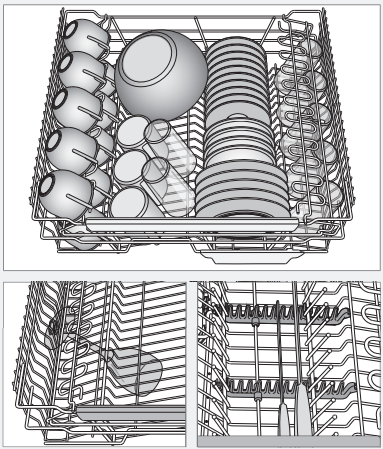
Foldable tines
The foldable tines can be folded up or down to make it easier to load pots, bowls and glasses. Release the foldable tines by pressing the catch inwards before adjusting their position.
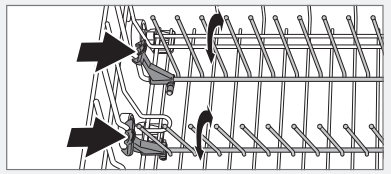
Raising the upper basket
- Pull out the upper basket.
- Grab the sides of the upper basket with both hands and lift it up.
Lowering the upper basket
- Pull out the upper basket.
- Pull out the two locking handles on either side to lower the upper basket.
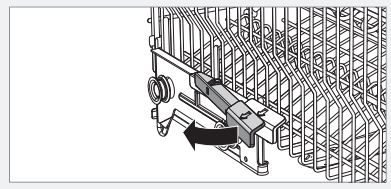
Lower basket
Place plates, side plates, serving dishes, pots and cutlery (in the cutlery basket) in the lower basket.
Place pots and pans in the rear right part of the lower basket to achieve the best dishwashing results from the rear of the two spray nozzles (WideSpray™), which are intended for these types of dishes.
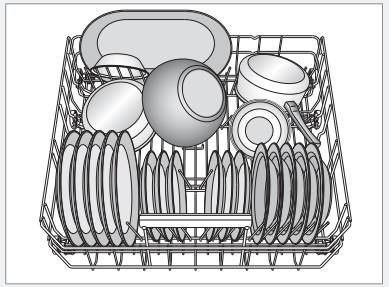
Foldable tines
Lower the foldable tines (plate supports) when washing pots and pans. Release the foldable tines by pressing the catch inwards before adjusting their position. In the right-hand rear part of the lower basket, half the foldable tines can be lowered for washing stoneware or a deep pan, for example.
Vase and bottle holder

Washing large plates
Move the foldable tines and their mounts to widen the distance between the tine rows to adapt the lower basket to plates with a diameter greater than 25 cm.
Cutlery basket
Place cutlery with the handles facing down, except for knives, and spread them out as much as possible. Ensure that spoons do not stack inside each other.
The cutlery basket is best placed in the middle at the front of the lower basket to best utilise dishwashing performance from the unique spray nozzle (Power Zone Cutlery™), which is intended for the cutlery basket.
Fold-down section for small items
The cutlery basket has a fold-down section in the middle for small items, or small shafts, such as electric whisk attachments.

Cutlery basket with lid
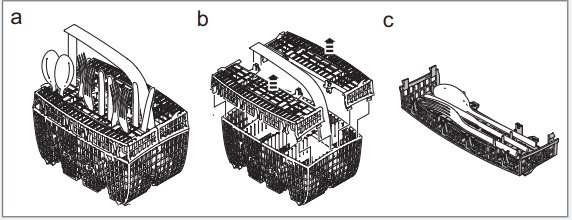
Positioning of cutlery basket lid (in upper basket)
The cutlery basket lid can be removed and used, for example, as an extra cutlery basket in the upper basket (see below).
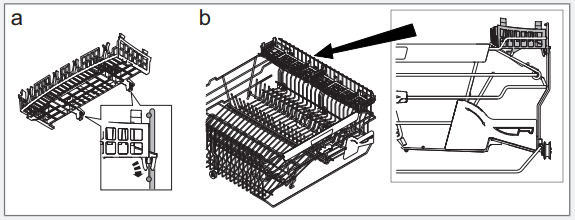
Using the dishwasher
Add detergent

- Prewash detergent compartment
- Main wash detergent compartment
Detergent is added according to water hardness.
Follow the instructions on the detergent packaging.
Too much detergent can result in less effective dishwashing and also entails greater environmental impact.
Add the detergent to the detergent compartment. There is a compartment for the prewash and one for the main wash. If powder and liquid dishwasher detergents are used, add a small amount of the detergent to the prewash compartment. Contact the detergent manufacturer if you have any questions about the detergent.
Dishwasher tablets
Halve the tablet if it is difficult to close the dispenser lid. There is a risk that the detergent will not be released properly if the lid is tight and will not open correctly.
3–in–1/All-in-one detergent
Read through the directions for these products carefully. If anything is unclear, contact the detergent manufacturer.
 On/Left-on mode
On/Left-on mode
Press and hold the On/Left-on mode button until the display lights up.
Program selection
Press the Program selector one or more times until the desired program symbol appears on the display.
 Auto wash
Auto wash
The dishwasher can measure how dirty the dishes are and adjust water consumption and temperature accordingly. When newly installed, the program needs to be run five times before it is fully adapted and can provide the best results.
 Time program
Time program
The program adapts to the specified running time or finish time. With this program it is important to choose a time suited to how dirty the dishes are
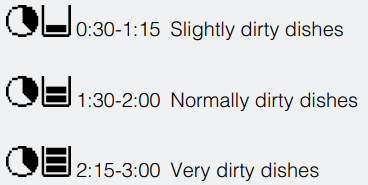
To set the program time, see the section Selecting Options.
 Heavy wash
Heavy wash
Program for very dirty dishes, such as pans, casserole dishes and oven dishes. If these dishes do not completely fill the dishwasher, you can add plates and the like.
 Normal program
Normal program
Use to wash normally dirty dishes, such as plates, serving dishes, cups, glasses and so on.
 Daily wash
Daily wash
A program suitable for day-to-day dishwashing. This program can also clean dried leftovers, but is not intended for burnt food, such as on oven dishes.
 Quick wash
Quick wash
This program is used for glasses and porcelain that is slightly dirty, such as coffee cups.
 Hygiene wash
Hygiene wash
This program is designed to meet strict hygiene demands.
 Delicate wash
Delicate wash
If the dishes are not very dirty, you can select Delicate wash. This program is intended for glasses and porcelain that have just been used and as such do not require such a powerful program.
This program can be used for delicate dishes. Select Short dry if you want to be especially cautious. See also the section Fragile dishes in Chapter Loading the dishwasher.
 Eco wash
Eco wash
Use when you want to save water. For normally dirty dishes.
 Upper half wash
Upper half wash
You can use this program if you only have cups and glasses that need washing in the upper basket. Slightly dirty dishes can also be placed in the lower basket.
 Lower half wash
Lower half wash
You can use this program when you only want to wash plates and cutlery in the lower basket. Slightly dirty dishes can also be placed in the upper basket.
 Rinse & Hold
Rinse & Hold
Used to rinse dishes while you wait for the dishwasher to become fully loaded.
Selecting Options
To select an option, press one of the option buttons. The field under the button lights when the option is activated. The available options depend on the selected program. Once you have started the program, the options you selected are saved for the next time you use the same program. An exception is the Delayed start option.
 High temperature
High temperature
Activate this option for improved dishwashing results. The machine then uses a higher temperature for the main wash.
If you want to use the lower temperature, press again so that the field under the button turns off.
You can vary the temperature as shown below:

 Long dry
Long dry
The higher temperature in the final rinse and longer drying improves the drying result if you activate the Long dry option. This causes a slight increase in energy consumption. This option can be used with all programs except Time program, Hygiene wash and Rinse & Hold.
If you want a program with Short dry, press again so that the field under the button turns off.
 Delayed start
Delayed start
When you select Delayed start, the dishwasher will start 1–24 hours after you press the Start/Stop button.
- Press the button once to activate Delayed start. Press the button several times – or hold it in – to set the desired number of hours.
- Press Start/Stop and the dishwasher counts down 1 hour at a time and starts after the selected delay.
Press and hold Start/Stop for three seconds if you want to cancel the Delayed start option.
 Set time
Set time
Press the option button several times – or hold it in – to set the desired program time for Time program. You can choose a program time between 30 minutes and 3 hours.
Start the dishwasher
Press and hold Start/Stop until the display shows  (the door open symbol). This indicates that the dishwasher is ready to start. Close the door properly, otherwise the dishwasher will not start. The display flashes three times with the remaining time to indicate that the program has started.
(the door open symbol). This indicates that the dishwasher is ready to start. Close the door properly, otherwise the dishwasher will not start. The display flashes three times with the remaining time to indicate that the program has started.
Time remaining
Once you have selected a program and options, the display indicates how long the program took the last time it was used. Once you have started the dishwasher, the display indicates how much program time remains. The remaining time is updated after the water for the final rinse has been heated.
This may differ somewhat from time to time depending on the temperature of the water supply, the amount of dishes, the ambient temperature and other factors.
While the program is running, the time counts down and the remaining program time is shown on the display. The remaining time is shown, for example, as 1:15, which means the program will run for another 1 hour and 15 minutes.
Stopping or changing a program
If you want to change program after starting the dishwasher, open the door then press and hold Start/Stop for three seconds. Add more detergent if the lid of the detergent dispenser has opened. Then choose a new program, press Start/Stop and close the door.
Do you want to add more dishes?
Open the door. The dishwasher stops automatically. Add the dishes, close the door and the dishwasher continues the program
If the dishwasher is turned off using the On/Left-on mode button or due to a power failure
If the dishwashing program was not finished, the interrupted program continues when power is restored.
Once the program has finished
Once the program has finished, “End” appears on the display. At the end of the program, you will hear a short beep. Chapter Settings describes how to change this function. Once the dishwasher has finished, it only uses standby power.
Drying
For additional drying the door should be opened 35 mm upon completion of the drying cycle. For more information, see page 17 in the chapter Technical information.
Settings
Do as follows to open the settings menu:

1. First, open the door. Turn off the dishwasher using the On/Left-on mode button (press and hold). Release the button.
2. Press and hold the On/Left-on mode button until the display lights up.
3. Within five seconds, press and hold the Program selector and the Long dry button.
4. Release the buttons when the display shows 

You can now adjust the following settings:

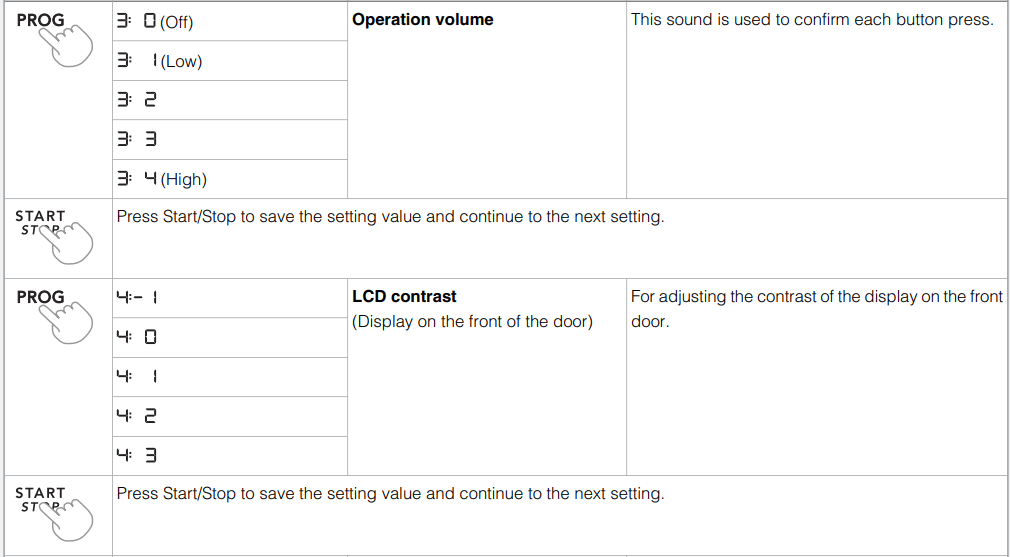
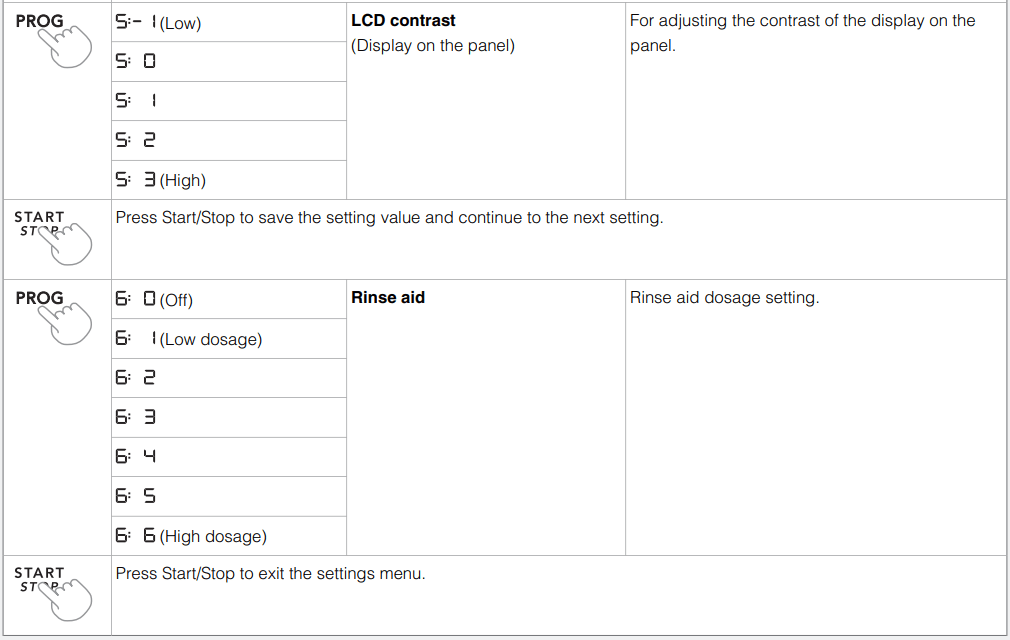
Care and cleaning
Coarse filter
The coarse filter traps larger food particles, which cannot get past the drainage pump. Empty the coarse filter as necessary.
- Lift the coarse filter by the handle.
- Empty the coarse filter. Remember to replace it!

Fine filter
Debris that collects on the fine filter is automatically rinsed away during each wash. However, the fine filter and its pipe section should be cleaned a couple of times a year.
1. Turn the handle anticlockwise once.
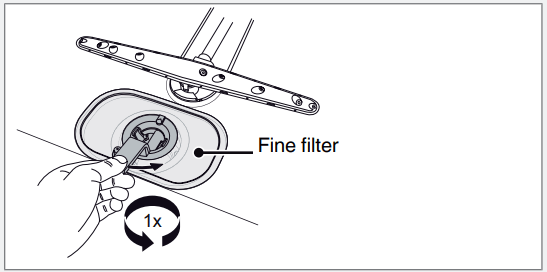
2. Lift the pipe section straight up by the handle. Free the coarse filter to clean the pipe section.
3. Remove and clean the fine filter.
4. Replace in reverse order. Check that the edges seal properly when replacing the fine filter.

5. Lock the filter in place by turning the handle clockwise to the stop position. The handle should point straight out from the dishwasher.

Drainage pump
The pump can be accessed from inside the dishwasher.
1. Cut the power to the dishwasher by pulling out the plug from the wall socket!
2. Remove the coarse filter and pipe section.
3. Remove the small yellow fitted piece at the left of the bottom drain (see illustration below).
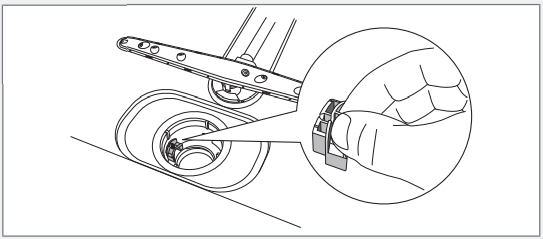
4. By inserting your finger into the hole you can turn the pump blade to release anything blocking it.

5. Reinstall the fitted piece and filters.
6. Plug the machine in again. If the dishwasher still does not start and a whirring sound is heard, the overflow protection has been activated.
- Shut off the water.
- Remove the plug from the wall socket.
- Call the service division.
NOTE! Do not forget to reinstall the fitted piece.

Spray arms
Holes and bearings can sometimes become blocked. Remove any debris using a pin or something similar. The spray arms also have holes on their undersides. To facilitate cleaning, you can remove the spray arms. Remember to screw them firmly back into place afterwards.
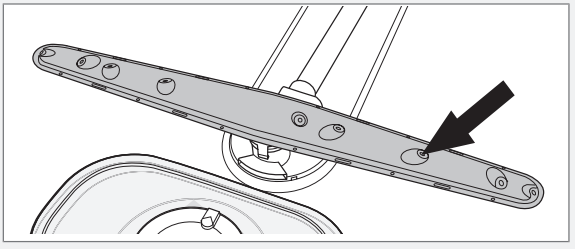
Lower spray arm
- Pull the lower spray arm straight up to release it.
Upper spray arm
- Pull out the upper basket.
- Unscrew the spray arm bearings counterclockwise to remove the spray arm from the upper basket.
Top spray arm
- The upper basket must be removed before the top spray arm can be released. Pull out the upper basket and turn the basket catch on each runner outwards (see illustration). The basket can now be removed.
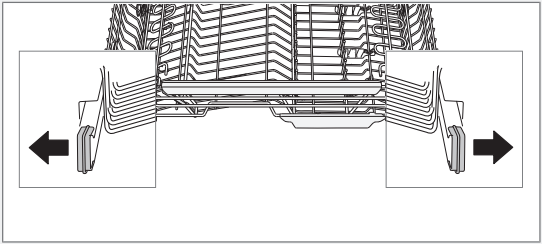
- Pull out the top cutlery tray. Press the top spray arm up and unscrew the spray arm bearings counter-clockwise to remove the spray arm.
Door
When cleaning the edge around the door, use only a slightly damp cloth (with a little cleaner if necessary).
WARNING! Do not use a spray bottle or the like around the door lock. This is to ensure that water does not penetrate the door catch and come into contact with the electrical components.

Limescale deposits
The dishwasher tub is made of stainless steel and is kept clean through normal use. However, if you have hard water, limescale deposits may form in the dishwasher. If this happens, run the Normal program program with high temperature and two tablespoons of citric acid in the detergent compartment (with no dishes in the machine).
Front panel
Keep the touch buttons clean and free from grease. Wipe them clean with a dry or slightly damp cloth. Never use cleaners – they can scratch the surface. Use the On/Left-on mode button to turn off the dishwasher before cleaning the touch buttons to avoid activating any buttons unintentionally.
Troubleshooting
Display | Type of fault | Action |
F: 10 | Overfilling | Call the service division. |
F: 11 | Water outlet fault | See "Water remains in the dishwasher" in the table below. |
F: 12 | Water inlet fault | Check that the water tap is on. Check whether dishwasher inlet hose is connected to a pressure limiting valve (some pressure limiting valves may restrict the supply of water to the dishwasher). |
F: 40 | Inlet valve leakage | Turn off the water tap and call the service division. |
Turn off the machine with the On/Left-on mode button and then turn it on again to clear the error message from the display.
Problem | Possible causes | Action |
The dishes are not clean. | The spray arms do not rotate. | Remove the arms and clean them. |
|
| Check that the dishes are not blocking the spray arms. |
| Old detergent. Detergent is a perishable product. | Avoid large packages. |
| Incorrect detergent dosage. | Dose according to water hardness. Far too much or far too little detergent results in poorer dishwashing results. |
| Dishwashing program too weak. | Select a higher temperature or a more powerful program. |
| Dishes loaded incorrectly. | Do not cover porcelain with large bowls or the like. Avoid placing very tall glasses in the corners of the baskets. |
| Glasses and cups have toppled over during the program. | Place dishes to sit steady. |
| The filter is not correctly fitted. | Screw the filter firmly into place. See the section Care and cleaning. |
Spots or films on the dishes. | Incorrect rinse aid dosage setting. | See the sections Before washing for the first time and Settings. |
| Too high temperature and/or too much detergent can cause etching on crystal. Unfortunately, this cannot be repaired, only prevented. | Wash crystal at a low temperature and with a conservative amount of detergent. Contact the detergent manufacturer. |
The dishes have a sticky white/blue film. | Rinse aid dosage setting too high. | Reduce the amount. See the sections Before washing for the first time and Settings. If you have very soft water, you may want to dilute the rinse aid 50:50 with water. |
Spots on stainless steel or silver. | Some foodstuffs, such as mustard, mayonnaise, lemon, vinegar, salt and dressings, can mark stainless steel if left for too long. | Rinse off these types of foodstuffs if not starting the dishwasher immediately. Why not use the Rinse & Hold program. |
| All stainless steel can cause spots on silver if they come into contact during dishwashing. Aluminium can also cause spots on dishes. | Silver and stainless steel items should not come into contact during dishwashing. |
Spots left after washing. | Lipstick and tea can be difficult to wash off. | Use a detergent with a bleaching agent. |
Rattling sound when dishwashing. | The dishes are not correctly placed or the spray arms are not rotating. | Check that the dishes are placed securely. Spin the spray arms to make sure they can rotate. |
The dishwasher does not start. | The Start/Stop start button has not been pressed for long enough. | Press and hold Start/Stop until the display shows |
| The door is not properly closed. | Check. |
| A fuse/circuit breaker has been tripped. | Check. |
| The plug is not plugged into the wall socket. | Check. |
| The water tap is turned off. | Check. |
| Overflow/leaks | Check. |
| A whirring sound (the drainage pump) is heard from the dishwasher and does not stop when the power is cut with the On/Left-on mode button. | Turn off the water tap. Pull out the plug and call the service division. |
| Check that the Delayed start option has not been selected. | Press and hold Start/Stop for three seconds if you want to cancel the Delayed start option. |
1 minute appears in the display. | The program is taking longer than estimated. | None, next time the program is run the corrected time will be displayed. |
Water remains in the dishwasher. | Blocked drainage hose. | Loosen the drainage hose where it connects to the sink unit's water trap. Check that no debris has fastened. Is the cone-shaped part of the pipe cut to an inner diameter of at least 14 mm? |
| Kink in drainage hose. | Check that the hose is free from kinks and sharp bends. |
| The filters are blocked. | Clean the coarse and fine filters. |
| The filter is not locked in completely. | Ensure filter is completely locked with handle pointing towards the door. |
| Debris in the drainage pump. | Clean the drainage pump. See the section Care and cleaning. |
Bad odour in dishwasher. | Dirt around the seals and in corners. | Clean with washing-up brush and lowfoam-ing cleaner. |
| Low temperature programs have been selected for a prolonged period. | Run a program with a higher temperature about once a month. |
The dishes are not dry enough. | Drying power too low. | Activate the Long dry option. |
| The dishwasher is not fully loaded. | Fully load the dishwasher. |
| Rinse aid needs topping up or dosage is set too low. | Top up with rinse aid or increase the rinse aid dosage. See the sections Before washing for the first time and Settings. |
|
| Open the door a little once the program has finished. |
Cannot close door. | The baskets are not correctly positioned. | Check that the baskets are correctly positioned horizontally. |
Check that the dishes are not blocking the baskets from sliding properly into place. | ||
The touch buttons do not react when pressed. | You have pressed the touch buttons too soon after opening the door. | Wait a moment then try again. |
Dirt on the touch buttons. | Clean with a dry or slightly damp cloth. | |
| Open the door until the display lights up. Alternatively, close the door and wait 30 seconds. Then open the door again. | |
Child lock (button lock) activated. | See the section Settings. |
See other models: HI1975G T884XLCHP CC4927S ODV8128G OCS8476S
 (the door open symbol). This indicates that the dishwasher is ready to start.
(the door open symbol). This indicates that the dishwasher is ready to start.
